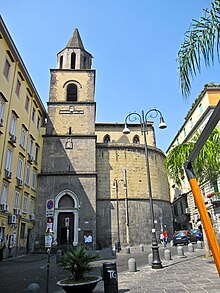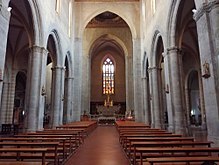San Pietro a Majella
This article includes alist of references,related reading,orexternal links,but its sources remain unclear because it lacksinline citations.(March 2015) |
| Church of San Pietro a Majella | |
|---|---|
| Chiesa di San Pietro a Majella | |
 Side façade with bell. | |
 | |
| 40°50′58″N14°15′11″E/ 40.849518°N 14.252974°E | |
| Location | Naples Province of Naples,Campania |
| Country | Italy |
| Denomination | Roman Catholic |
| History | |
| Status | Active |
| Architecture | |
| Architectural type | Church |
| Style | Gothic architecture |
| Administration | |
| Diocese | Roman Catholic Archdiocese of Naples |
San Pietro a Majellais a church inNaples,Italy.The term may also refer to the adjacentNaples music conservatory,which occupies the premises of the monastery that used to form a single complex with the church.
The church stands at the western end ofVia dei Tribunali,one of the three parallel streets that define the grid of the historic center of Naples; the church is considered one of the most significant examples ofAngevinarchitecture in Naples and was built at the wishes ofGiovanni Pipino da Barletta,one of the knights ofCharles II of Anjouand the one responsible for destroying the lastSaracencolony on the southern peninsula, inLucera.
San Pietro a Majella was built in the early 14th century inGotico Angioianostyle and was named for and dedicated to Pietro Angeleri da Morone, a hermit monk from Maiella (nearSulmona) who becamePope Celestine Vin 1294. He was the founder of the Celestine monastic order, which occupied the church until 1799, when monasteries were suppressed by theNeapolitan Republic.After the restoration of the monarchy, the monastery was reopened, but in 1826 was converted to house theSan Pietro a Maiella Conservatory,a function it preserves. The church underwent restoration in the 1930s and remains an open and active house of worship.
As was the case with much Angevin architecture in Naples, San Pietro a Majella underwent a Baroque make-over by the Spanish in the 17th century, but 20th-century restoration attempted to "undo" that and to restore the building to its original Gothic appearance.
Interior[edit]
The interior has three naves, separated by pillars supporting Gothic arches, with nine lateral chapels, plus four on each side of the chancel, and transept. The 14th century tomb ofGiovanni Pipino da Barletta,architect of the church, is placed on the counter-façade. The tomb was designed byGiovanni Barrile,while the tombs of Petra family members are by the Neapolitan sculptorLorenzo Vaccaro.
The main altar was completed in the seventeenth-century, built byCosimo Fanzago,andPietroandBartolomeo Ghetti,is decorated with large vases and candlesticks in silver and preceded by abalustradecovered in polychrome marbles. It stands on it a fifteenth-century wooden crucifix, while behind there are frescoes of the 17th century and 16th century sculptures.

The ceiling of the nave, with drawers, and the transept feature paintings byMattia PretidepictingEpisodes from the life of St. Peter CelestineandSaint Catherine of Alexandria(1657–59).
The works on the nave, starting from the entrance, are:
- Accompanied by Charles II of Anjou with the Cross, St Peter Celestine the hermit becomes Pope
- St Peter Celestine in prayer at the Maiella church
- Glory of St Peter Celestine in papal robes, accompanied by St. Benedict
- St Peter Celestine in prayer at the Maiella church, suffering temptation
- The saint with the tiara in hand, in the act of making the great refusal
The works of the transept, from left to right, are:
- St Catherine defends her faith in dispute with the sophists
- Develops stigmata in prison and assisted by the angels
- Beheading of the saint in front of the tyrantMaxentius
- Mystic Marriage of St Catherine
- Lifeless body of the saint, strewn with roses, is taken to heaven by angels
Chapels[edit]
- First chapel on left: There is a painting byNiccolo RossidepictingBishop San Biagio;chapel hasMaiolicatiles with designs typical ofAragon.
- Second chapel on left: This is the chapel of the Spinelli-Raetano family with two funerary monuments of the family of which the one on the left wall, is characterized by a bust of the Roman period depictingTrajan.TheAssumption of the Virgin(1705) painted byGiacomo del Po.
- Third chapel on left: Allows entry or exit, toPiazza Luigi Miragliathrough port placed under the bell tower.
- Fourth chapel on left: Houses three tombs, one of which appears to be the tomb of the philosopher, physician and scientistLeonardo Di Capua.The chapel is also characterized by decorations in marble and aCrucifixionbyDomenico Viola.
- Fifth chapel on left: The chapel is dedicated to the Colonna-Zagarolo family. Contains three paintings byFrancesco De Mura:Preaching Santoronzo(altar ),Baptism of St. Horace(left wall) andMartyrdom of St. Horace(right wall).
- Transept - left apse: Dedicated to the Petra family, the chapel houses in the two side walls the funerary monuments ofDomenicoandVincenzo Petra,archbishop ofDamascus,cardinal,and member of theSacred Congregation for the Propagation of the Faith,both works ofLorenzo Vaccaro.In addition to the tiled floor, where there are two tombstones, one of 1739 toIsabella Altempsthe wife of the duke ofGallese,Nicholas Petra,the chapel is also characterized by a fresco depicting the Madonna del Soccorso.
- Transept - Second to the left of the apse chapel (Chapel Pippin): The floor is majolica tiles and is marked by a monument ofPaul SalbanaandGiottesquefrescoes depicting ‘’Stories of Mary Magdalene’’. The author of the frescoes from Bologna was identified with the anonymous "Master John Barrile" active inNaplesactive in the Barrile Chapel ofSan Lorenzo Maggiore.The cycle of frescoes may have been made earlier than 1356, the yearGiovanni Pepino,the buyer, died.

- Transept on the right of the apse: Contains works ofGiovanni da NolaandOnofrio De Leo.Of the first there is an altar with aDeposition(painting) and a sculpture of St Sebastian. The second there are two paintings,San Cristoforo da Padua with the host(1643) andSan Francesco di Paola in front of the Kings of Aragon breaking a coin from which radiates blood,and other paintings depicting the Madonna, San Domenico, John the Baptist and St Francis.

- Transept right of the apse chapel (Lionella Chapel): It has a cycle of frescoes dating depictingStories of St. Martin(1355-1360). The chapel also has sculptures in marble, representing two arms of which one of the family Lionella and the other, the family Petra (whose chapel is located inside the church, to the left of the apse), depicting a lion rampant holding a stone in one paw and a severed head in the other.
- First chapel on right: There is the tomb of the family Stinga.
- Second chapel on right: There is a painting ofSt Benedict takes leave from St ScholasticabyGirolamo Cenatiempo.
- Third chapel on right: The chapel was badly damaged duringWorld War IIand contains an altar and a painting of theSeven Holy Founders of the Servite Order(1892). Both come from the destroyed Church of St Thomas Aquinas.
- Fourth chapel on right: (Chapel of St. Peter): On the front is a painting byMassimo Stanzione,theMadonna appearing to St Peter Celestine,while on the sides there are two paintings by Cenatiempo: on the right,Nativity of St Peter C.,and leftDeath of St Peter Celestine(1711). Finally, in the vault and lunettes, also by Cenatiempo, areApotheosis of St. Peter Celestineand allegorical figures.
- Fifth chapel on right: There is aMarriage of St Catherineby Cenatiempo and aDream of St CatherinebyNicola Malinconico.
Notes[edit]
Sources[edit]
- De Lellis, De Minieri Riccio,Brevi notizie dell'archivio angioino,Naples 1872.
- A. Venditti,Urbanistica e architettura angioina,inStoria di Napoli,Naples 1969.
- O. Morisani,L'arte di Napoli nell'età angioina,inStoria di Napoli,Naples 1969.
- Celano - Chiarini,Notizie del bello dell'antico e del curioso,Naples 1972.
